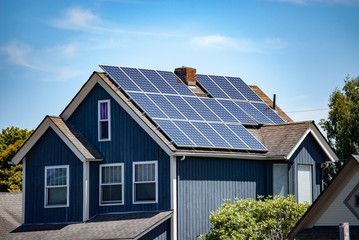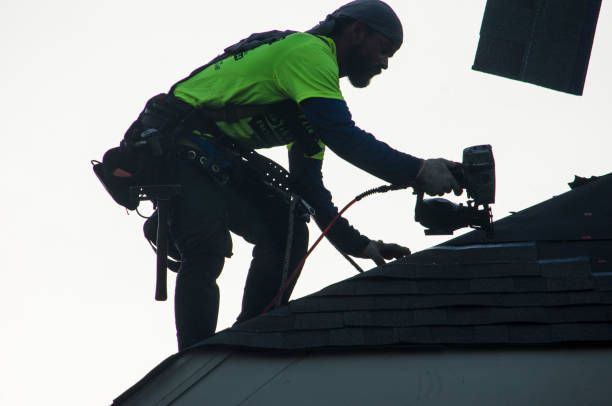Exploring Green Roofing Options for Sustainable Homes

Green roofing is quickly gaining popularity as homeowners become more conscious of sustainability and energy efficiency. Roofing company king of prussia not only enhances the aesthetic appeal of homes but also provides a range of environmental benefits. From reducing carbon emissions to improving stormwater management, green roofs offer a sustainable approach to roofing. In this blog, we will explore the different types of green roofs, including slate and clay tiles and asphalt shingles, their installation process, and the maintenance required to ensure their longevity. Additionally, we will delve into the importance of green Roofing Company King of Prussia and its role in creating sustainable homes for the future, including the use of metal roofing with sealants for added durability and environmental benefits.
Understanding Green Roofing
Green roofing, also known as vegetative roofing or living roofs, refers to the practice of planting vegetation on rooftops. It involves creating a layer of plants and soil on top of a building. Green roofs can be implemented on new roof constructions or as a retrofit option for existing buildings. Roofing Company King of Prussia plays a vital role in green roofing, providing a suitable foundation for the vegetation to thrive. By creating a sustainable and energy-efficient solution, green roofs have become increasingly popular among homeowners. Read about Roofing Excellence: Transforming Homes and Businesses with West Chester, PA Roofers to learn more.
Defining Green Roofing
Green roofing involves covering a roof with a layer of vegetation, providing numerous environmental benefits along with a distinctive aesthetic appeal. Whether it's a new roof or an existing one, homeowners can transform their rooftops into functional green spaces. The right roof is crucial for the success of green roofing, ensuring proper structural support and functionality. Homeowners should explore the various options available to find the right roof for their green roofing project.
Importance of Green Roofing
Green roofing is essential for homeowners committed to sustainability and energy efficiency. By implementing green roofs, homeowners can significantly reduce their carbon footprint while enhancing their living environment. These roofs provide natural insulation, reducing heating and cooling costs. Additionally, they contribute to stormwater management by retaining rainwater and preventing runoff, which improves overall water quality. By supporting biodiversity and providing habitat for urban wildlife, green roofs promote ecological balance in urban areas.
Types of Green Roofs
Green roofs come in various types, each offering unique benefits and design considerations. The two primary types of green roofs are extensive and intensive green roofs. Extensive green roofs are lightweight, low-maintenance options that are suitable for retrofitting existing buildings. On the other hand, intensive green roofs, with their deeper soil profiles, allow for a greater variety of plants, including trees and shrubs. Let's explore each type in more detail
Extensive Green Roofs
Extensive green roofs are characterized by their shallow soil depth, typically ranging from 2 to 6 inches. They are relatively lightweight, making them a suitable option for retrofitting existing buildings. Here are a few key points about extensive green roofs:
- Soil substrates: Extensive green roofs use lightweight soil substrates, which help retain moisture while allowing for proper drainage.
- Plant selection: Hardy, low-maintenance plants such as sedum and grasses are commonly used on extensive green roofs.
- Maintenance: Extensive green roofs require minimal maintenance, with occasional weeding and fertilizing to ensure plant health.
- Cost-effective: These roofs are an affordable green roofing option, making them accessible to a wide range of homeowners.
Intensive Green Roofs
Intensive green roofs, also known as roof gardens, are designed with deeper soil profiles, allowing for a diverse selection of plants, including trees, shrubs, and even small gardens. Here are a few key points about intensive green roofs:
- Design considerations: Intensive green roofs require careful planning, considering factors such as wind exposure, microclimates, and architectural shingles.
- Biodiversity: Intensive green roofs offer ample space to support a wide range of flora and fauna, contributing to biodiversity in urban areas.
- Recreational space: With their deeper soil profiles, intensive green roofs provide additional recreational space for residents, promoting an eco-friendly lifestyle.
- Aesthetic value: Intensive green roofs enhance the overall aesthetic appeal of buildings, creating a visually appealing green oasis in urban environments.
'
Benefits of Green Roofing
Green roofing offers several benefits, making it an attractive option for homeowners looking to create sustainable homes. Let's explore some key advantages of green roofing, including improved energy efficiency, stormwater management, and enhanced biodiversity.
Maintenance of Green Roofs
Proper maintenance is crucial to ensure the longevity and functionality of green roofs. Regular care, including watering, fertilizing, and weeding, is necessary to keep the vegetation healthy. Let's explore some key maintenance practices for green roofs
Watering and Fertilizing
Watering and fertilizing green roofs require careful consideration to maintain plant health while avoiding water runoff. Irrigation systems can be installed to ensure proper watering, regulating moisture levels effectively. Fertilizing practices provide necessary nutrients for the vegetation, promoting healthy growth. Following a fertilization schedule and regularly inspecting the roof for watering and fertilizing needs contribute to the overall sustainability of the green roof.
Weeding and Pruning
Weeding and pruning are essential tasks to maintain the health and aesthetic appeal of green roofs. Removing invasive species prevents them from overtaking the vegetation and competing for resources. Pruning helps maintain plant shape, promotes new growth, and enhances the overall appearance of the roof. Regular weeding and pruning routines, tailored to specific plant species and seasonal care needs, ensure the long-term success of the green roof.
Case Studies of Green Roof Applications
Examining successful examples of green roof applications provides valuable insights into their real-world benefits. Let's explore two case studies—one focused on residential buildings and the other on commercial buildings—to understand the impact of green roofing on different types of structures.
Residential Buildings
Green roofs are increasingly being implemented in residential buildings, offering numerous advantages to homeowners. In a case study of a residential project, the installation of a green roof resulted in improved insulation, reducing energy costs for the homeowner. Additionally, the green roof enhanced the aesthetic appeal of the home, providing a beautiful, natural space for relaxation and gardening. The cost-benefit analysis of the project revealed that the long-term savings on energy expenses outweighed the initial investment, making it a wise choice for the homeowner.
Commercial Buildings
Green roofs also provide significant value to commercial buildings, contributing to corporate sustainability goals and addressing urban challenges. For instance, a case study of a commercial building demonstrated how the implementation of green roofs reduced the urban heat island effect, lowering cooling costs and improving employee comfort. The creation of green spaces on the rooftop also provided a recreational area for employees, leading to increased overall well-being and productivity. Commercial buildings can leverage green roofing to support sustainability initiatives while transforming unused rooftop spaces into vibrant, eco-friendly environments.
The Future of Green Roofing
As technology continues to advance, green roofing is poised to play an increasingly significant role in sustainable home construction. Technological innovations such as solar attic fans and power roof vents with Wi-Fi and smartphone connectivity are improving the efficiency and performance of green roofs, making them more accessible and attractive to homeowners. Let's explore the future of green roofing, including these advancements and its potential as a solution for sustainable homes.
Technological Advancements
The future of green roofing lies in technological advancements that optimize the performance and functionality of these eco-friendly roofs. Smart technology, such as sensors and data analytics, allows for real-time monitoring and adjustments, ensuring optimal water usage and plant health. Climate adaptation solutions, such as innovative irrigation systems, help green roofs withstand extreme weather conditions. Furthermore, ongoing innovation in materials and installation techniques continues to improve the efficiency and longevity of green roofs, making them an even more promising option for sustainable homes.
Is Green Roofing the Future of Sustainable Homes?
Green roofing aligns with current green building trends and is expected to experience significant market growth in the coming years. As homeowners increasingly prioritize sustainability and energy efficiency, green roofing offers a comprehensive solution to reduce environmental impact. With its countless benefits, including improved energy efficiency, stormwater management, and enhanced biodiversity, green roofing has the potential to become a fundamental element of sustainable homes, contributing to a greener, more sustainable future. However, it is important to carefully consider the type of roofing shingles, such as solar shingles and fiberglass shingles, used in green roofing and to hire a specialized roofer who can install them properly to ensure they are environmentally friendly and sustainable. Additionally, it is crucial to hire a roofer who is knowledgeable and experienced in building-integrated photovoltaics (BIPV) to ensure the proper installation of solar shingles, which can be a costly investment for homeowners.
Conclusion
Spring Valley Roofing provides a sustainable solution for eco-conscious homeowners. By understanding the benefits of green roofs, from energy efficiency to promoting biodiversity, you can make a positive impact on the environment. With advancements in technology, the future of sustainable homes lies in embracing green roofing options. From extensive to intensive green roofs, the installation and maintenance processes are crucial for long-term success. By choosing the right materials and plants, you contribute to a greener future while enjoying the numerous advantages that green roofs offer. Explore the possibilities of green roofing and pave the way for a more sustainable living environment. Call our experts today!
Frequently Asked Questions: Spring Valley Roofing
What is a green roof covering?
Green roof covering pertains to the materials on a building's roof that support plant growth. It includes waterproof membranes, root barriers, drainage layers, and growing medium. These coverings aid in energy savings, stormwater management, and insulation. Popular options are EPDM rubber, PVC, TPO, and modified bitumen membranes.



